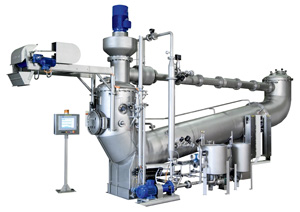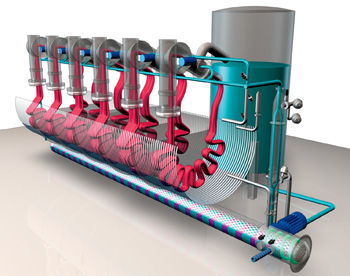F
or centuries, water has been the most important element in textile finishing. Today, it
constitutes an increasingly expensive medium.
Germany-based Then Maschinen GmbH’s Airflow® dyeing concept was invented by Wilhelm Christ
and subsequently patented in 1978 by Then, which produced the first prototype. Over the years, the
system was developed further according to the requirements of the industry.

The long tube design, superior fabric displacement and gentle polytetrafluoroethylene rods
contribute to the success of smooth treatment meeting high quality demand for Then Maschinen’s
newly developed Airflow® Lotus 200 dyeing machine.
Air Instead Of Water
Airflow was the key element of the technology, as air is an ideal transport medium. The
replacement of dye liquor with air as a method of transporting piece goods in jet-dyeing machines
was a big step toward reducing water and chemicals consumption. Compared to the jet system in which
the nozzles are filled with liquor, nozzle pressure is negligible, thus offering optimum protection
of sensitive textile surfaces. At the same time, the use of the mass flow principle provides a
major improvement in fabric hank laying, thus preventing creasing.
The moisture-saturated airflow ensures the uniform distribution of temperature on the fabric
and in the machine, constituting a prerequisite for even and reproducible dyeing. Moreover, the low
level of liquor in the dyeing boiler means the fabric is lighter than in conventional machinery and
can therefore be accelerated quickly to high speeds. Thus, the risk of draft or strain is minimal,
which is particularly advantageous with regard to the finishing of items containing elastane
fibers.
The high transportation speeds of the fabric result in very short fabric turn time. High
heating-up gradients are possible because a very low liquor ratio is maintained. The unique ability
to use a hot drain system and rinsing with fresh water in a running wash system considerably
reduces the time required for the dyeing process.
The Airflow technology represents the combined result of the entire range of possibilities
provided by the technology. Through the interplay of all technical possibilities and functions,
economic and ecological advantages over the traditional dyeing technology are achieved. The main
advantages are as follows:
- unlimited flexibility with regard to all fiber – except pure wool – and fabric weight classes
between 30 and 800 grams per square meter, as well as all standard market dyestuffs; - the lowest liquor ratio on the market: approximately 1:2 for man-made fibers and 1:3 to 1:4 for
natural fibers, depending on the article and structure; - energy savings of up to 40 percent, thanks to a frequency converter, and the use of air as a
transport medium, while all other systems need water; - a reduction in the overall process time of approximately 25 percent; and
- lowest water/wastewater levels.
The New L-shape Airflow
However, the Airflow dyeing machine had one disadvantage: dyeing of extremely delicate
fabrics didn’t give a perfect result. Current and future trends pointing toward more and more
lightweight fabrics with high contents of elastane in finest yarn counts and gauges prompted the
next stage of Airflow machinery design.
To meet the required voluminous hand as well as top-grade quality standards, the world’s
first long-tube Airflow machine, the Airflow Lotus 200, was developed. The new dyeing machine
incorporates the latest advances in Then’s Airflow technology and operates according to the
original aerodynamic principle. The dye liquor passes the self-cleaning filter and is then evenly
applied and finely distributed as a mist with the aid of the blower, assuring outstanding
penetration, according to Then.

Schematic drawing of the Airflow® technology: Air is the key element, and is said to be the
ideal medium to transport piece goods in dyeing machines.
Handling Delicate Fabrics
The Airflow Lotus 200 is said to be especially suitable for the wet finishing of delicate
cellulose- and man-made-fiber knitwear and woven fabrics with a high percentage of elastane. Such
fabrics are used in the automotive, lingerie, sports-, leisure- and swimwear segments. Close
attention has also been paid to the achievement of significant savings of precious water and energy
resources — similar to the Airflow Synergy dyeing machine.
Extremely safe and gentle product running and outstanding displacement comprise Airflow Lotus
200’s characteristics. With its concept in machine design, unmatched results in process technology
and unparalleled achievements regarding economy and ecology, the new machine will substantially
extend the field for aerodynamic applications, Then reports.
The newly designed dome blower ensures that the fabric is transported just by air. This means
the liquor actually is used to do what it is meant to do: dyeing only. The liquor ratio is reduced
to between 1:2 and 1:5 and provides savings in terms of water and water treatment, chemical, and
energy costs. This will bring up to 80-percent savings of liquor compared with costs associated
with outdated hydraulic machines, as well as significant savings of time. Shortest cycle times and
loadings of up to 1,200 meters for lightweight fabrics and up to 200 kilograms for average articles
allow high daily production rates.
Polyamide Dyeing
Most of the fabrics for lingerie, swimwear and automotive applications are made of polyamide.
That’s why the new L-shape dyeing machine handles fabrics made of 100-percent polyamide with the
same results as previously mentioned fabrics. Then’s Roland Adrion, senior sales manager, says that
“current and future trends point towards more and more lightweight fabrics with high contents of
elastane in finest yarn counts and gauges. Meeting the [voluminous hand specifications] as well as
top-grade quality standards were there when we developed the world’s first long tube Airflow
machine, the Airflow Lotus.” Perhaps a more appropriate name for the new machine would have been
“Longflow.”
March/April 2010




